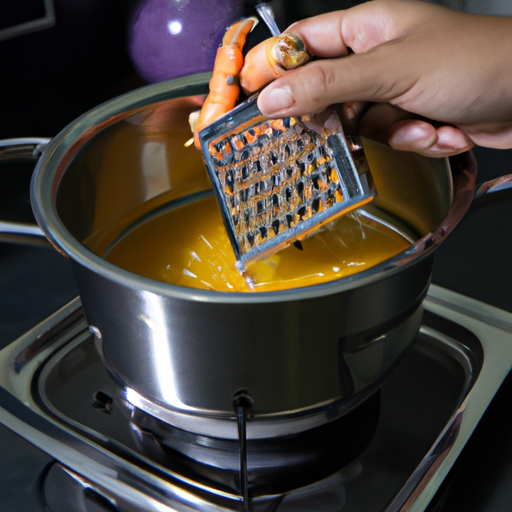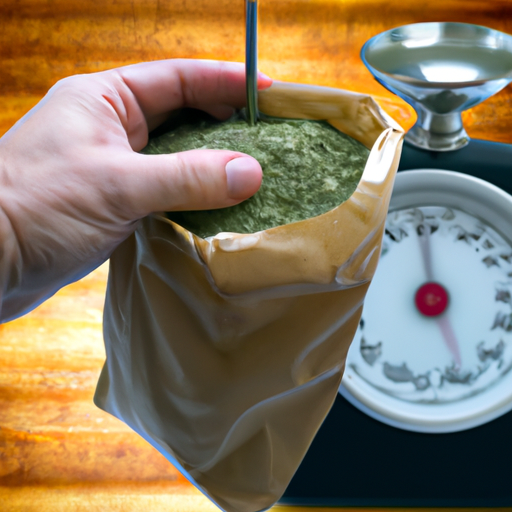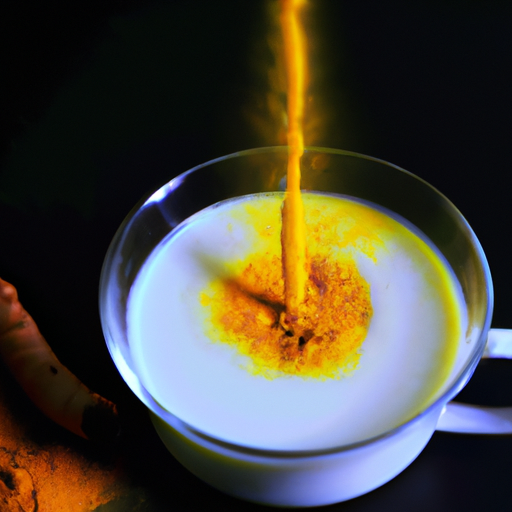As sunlight floods through my window with the dawn, a feeling of excitement washes over me. Today, I’m going to share a family heirloom of a recipe with you – the method of preparing turmeric tea using the root.
This golden-hued drink has gained immense popularity over the years due to its numerous health benefits and delicious taste. Turmeric is widely known for its anti-inflammatory properties and can help reduce joint pain, improve brain function, and support heart health.
Making turmeric tea from root is incredibly easy and requires only a handful of ingredients that you probably already have in your pantry. So let’s roll up our sleeves and get started on making this refreshing beverage that’s sure to become a staple in your daily routine!
Key Takeaways
- Freshly grated or sliced turmeric root is the main ingredient in making turmeric tea from root.
- Additional flavorings like ginger, cinnamon, and black pepper can be added to enhance the taste and offer additional health benefits.
- Timing and heat are key factors in making turmeric tea from root, and overheating or boiling for too long can lead to a bitter taste.
- Black pepper can boost the absorption of curcumin, the active compound in turmeric, by up to 2000%.
Gather Your Ingredients
So, you’ve decided to make yourself a delicious cup of turmeric tea from root, and I’m here to guide you through the process.
The first step is to gather your ingredients – fresh turmeric root being the most important one. You can also add additional flavorings like ginger or cinnamon, depending on your taste preference.
Once you have everything ready, it’s time to boil some water and add sweetener if desired.
Let’s get started!
Fresh Turmeric Root
To prepare fresh turmeric root for your tea, you’ll need to peel it first before grating or slicing it into small pieces. Turmeric root has been used in Ayurvedic medicine for thousands of years due to its numerous health benefits. It contains a compound called curcumin, which has strong anti-inflammatory and antioxidant properties. Consuming turmeric regularly can also help boost the immune system and improve digestion.
Aside from making tea, there are also alternative uses for fresh turmeric root. You can add it to smoothies, juices, soups, or even use it as a natural food coloring agent. Its bright orange-yellow color will give your dishes a vibrant hue without using any artificial additives.
Now that you’ve prepared the fresh turmeric root for your tea, let’s move on to adding some additional flavorings.
Additional Flavorings
As you add some extra flavorings to your fresh turmeric tea, the warm and inviting aroma will fill your senses with a cozy comfort that reminds you of home. Not only do these flavorings enhance the taste of your tea, but they also offer additional health benefits.
Adding a dash of black pepper can boost the absorption of curcumin, the active compound in turmeric responsible for its anti-inflammatory properties. Ginger can add a spicy kick while also aiding digestion and reducing nausea. Cinnamon adds a subtle sweetness while improving blood sugar control.
There are endless recipe variations for turmeric tea, so don’t be afraid to experiment with different flavors and ingredients to find what works best for you. Some people enjoy adding honey or maple syrup as natural sweeteners, while others prefer coconut milk for a creamier texture. Whatever your preference may be, make sure to use high-quality ingredients and adjust the amount according to taste.
Now that we’ve added our desired flavorings, let’s move on to preparing our water and sweetener for the perfect cup of turmeric tea.
Water and Sweetener
When preparing a cup of turmeric tea, it’s important to choose the right water and sweetener to enhance its taste and nutritional value. Here are some tips:
-
Use filtered or spring water. Tap water can have impurities that may affect the taste. Filtered or spring water will ensure a clean and crisp flavor.
-
Avoid using white sugar. While sweeteners are optional, if you use one, avoid white sugar which has no nutritional value. Try natural sweeteners like honey or maple syrup.
-
Experiment with spices. Turmeric tea already has a slightly spicy flavor, but adding other spices like cinnamon or cardamom can give it an extra kick.
-
Don’t overdo it. A little sweetener goes a long way in enhancing the taste without overpowering the natural flavor and health benefits.
When selecting a sweetener, keep in mind the many benefits of turmeric tea including anti-inflammatory properties and improved brain function. With these tips in mind, let’s move onto the next step: preparing the turmeric root!
Prepare the Turmeric Root
First things first, grab your trusty vegetable peeler and gently remove the skin from the turmeric root. Peeling tips to remember: use gloves or wash your hands thoroughly after handling the root as it can leave yellow stains on skin and clothing. It’s also important to note that if you don’t have fresh turmeric root, you can substitute with dried turmeric powder. However, fresh turmeric root has a stronger aroma and flavor than its powdered counterpart.
Once you’ve peeled the turmeric root, chop it into small pieces or grate it finely depending on how strong you want your tea to be. Remember that a little goes a long way with this potent spice! If you find yourself without fresh turmeric root or powder, there are other alternatives such as ginger or cinnamon which also have anti-inflammatory properties.
Now that your turmeric is prepped and ready to go, it’s time to boil some water for the tea. Simply bring water to a boil in a pot on the stove or heat it up in an electric kettle until it reaches boiling point. Don’t forget that adding black pepper can increase bioavailability of curcumin – the active ingredient in turmeric – so consider adding some freshly ground black pepper before pouring hot water over your chopped/grated turmeric.
Boil the Water
To continue with our discussion on how to make turmeric tea from root, the next step is to boil the water. As I’ve mentioned earlier, it’s important to use filtered water that isn’t too hot or too cold. I usually fill a kettle with water and place it on the stove at medium heat until it reaches boiling point.
Here are some things you may want to keep in mind while boiling the water:
- Use a pot or kettle that can hold enough water for your desired serving size.
- Filtered water is always best as tap water can be harsh and contain chlorine.
- Keep an eye on the temperature of the boiling water – you don’t want it too hot or too cold.
- Wait for the bubbles to appear before turning off the stove.
Now that we have boiled our filtered water, let’s move onto discussing some benefits of turmeric tea and different ways to brew it.
Turmeric has been used for centuries in Ayurvedic medicine due to its anti-inflammatory properties and ability to boost immunity. It has also been linked with improved brain function, lower risk of heart disease and cancer prevention.
There are many ways you can brew turmeric tea – some people prefer adding milk or honey while others like their tea plain with just turmeric and ginger. You can also add black pepper which helps increase absorption of curcumin (the active ingredient in turmeric) by up to 2000%. Experiment with different flavors until you find what suits your taste buds best.
Moving forward, we’ll now add the turmeric root and flavorings into our boiled filtered water for a delicious cup of turmeric tea!
Add the Turmeric and Flavorings
Now that the water’s boiling, it’s time to add the turmeric and other flavorings to make a delicious cup of tea.
Timing and heat are key factors in this step. I like to let the turmeric simmer for about 10 minutes on low heat to extract all its health benefits and give the tea a rich color.
Additionally, adjusting for taste is important as everyone has different preferences. I usually sweeten my turmeric tea with honey or maple syrup, but some people may prefer it without any added sweetness.
Timing and Heat
When making turmeric tea from root, optimal brewing is key to fully extract the benefits of this powerful spice. Temperature control plays a crucial role in ensuring that the turmeric is properly brewed.
It’s important to simmer the mixture on low heat for at least 10 minutes, as this allows enough time for the water to absorb all of the active compounds present in the turmeric. The amount of time and heat used can greatly affect the quality and taste of your turmeric tea.
Overheating or boiling for too long can lead to a bitter taste, while under-brewing may not release all of the healthful properties present in turmeric. Taking care with timing and temperature control will result in a deliciously balanced cup of tea that you can enjoy any time throughout your day.
Now, let’s move onto adjusting for taste to make sure your turmeric tea is perfectly suited to you!
Adjusting for Taste
For the perfect cup of turmeric tea, you’ll want to adjust the taste to your liking. Adjusting spice levels is a great way to make sure that your tea is not too overpowering or bland. You can add more or less turmeric depending on how strong you like it, or even mix in other spices such as ginger or cinnamon for added flavor.
Additionally, adding black pepper can increase the health benefits of turmeric tea. Curcumin, the active ingredient in turmeric, has low bioavailability on its own. However, when combined with piperine found in black pepper, absorption can increase by up to 2000%! So don’t be afraid to add a pinch of pepper to your tea for optimal health benefits.
Now that we’ve adjusted our spice and added some black pepper for increased bioavailability, it’s time to simmer the mixture and let all those flavors blend together.
Simmer the Mixture
As the mixture continues to simmer, the flavors of the turmeric and ginger root will infuse into the water, creating a delicious and healthy beverage. Not only is turmeric tea tasty, but it also has numerous health benefits.
Curcumin, an active ingredient in turmeric, has anti-inflammatory properties that can reduce pain and swelling in the body. Additionally, studies have shown that drinking turmeric tea may improve brain function and lower your risk of chronic diseases such as heart disease.
There are many variations of turmeric tea to suit different tastes. Some people prefer adding honey or lemon for sweetness while others like to add black pepper for better absorption of curcumin. Just remember to adjust the recipe based on your preference for taste. The longer you let it simmer, the stronger the flavor will be.
Once you’ve allowed the mixture to simmer for at least 10 minutes (but up to 30 minutes), it’s time to strain the tea. Straining removes any solid pieces from the mixture so that you’re left with a smooth liquid. You can use a fine-mesh strainer or cheesecloth to do this step.
Now that your tea is ready and strained, sit back and enjoy!
Strain the Tea
After simmering the turmeric root in water, it’s time to strain the tea. This step is essential to remove any impurities and make the tea smoother. Straining also helps to separate the liquid from the solid residue left behind by the turmeric root.
Here are some benefits of straining turmeric tea:
-
Improves texture: Straining removes any gritty or coarse bits of the turmeric root, resulting in a smoother texture.
-
Enhances flavor: Removing solids can help concentrate flavors and aromas for a more intense taste.
-
Removes impurities: Some particles may be left behind during simmering that can affect how your body absorbs nutrients from turmeric.
-
Prevents staining: Turmeric has a bright yellow pigment that can stain clothing and surfaces if not removed before drinking.
There are different methods you can use to strain your turmeric tea depending on what equipment you have available at home. You could use a fine-mesh sieve, cheesecloth, nut milk bag, or even coffee filters. Each method has its pros and cons, but they all work well in removing unwanted particles from your drink.
Now that we’ve strained our turmeric tea, let’s move onto sweetening and serving it up!
Sweeten and Serve
Now it’s time to add a touch of sweetness and enjoy your deliciously smooth and flavorful turmeric beverage! While some may prefer their tea unsweetened, others may want to add a little something extra.
Traditional honey or organic maple syrup are great natural sweeteners that complement the earthy flavor of turmeric. Not only do these alternative sweeteners give your tea a tasty boost, but they also come with their own healthy benefits. Honey has antibacterial properties and can soothe sore throats, while maple syrup is high in antioxidants and contains anti-inflammatory compounds.
These added benefits make the choice to sweeten your tea even more appealing. Once you’ve added your preferred sweetener, stir well until fully dissolved. Then sit back, relax, and savor all the nourishing qualities this golden drink has to offer.
But before you doze off into pure bliss, let’s talk about how to properly store and reheat any leftover tea for future enjoyment.
Storing and Reheating
Properly preserving and heating your turmeric tonic is pivotal for prolonged pleasure. After brewing your turmeric tea, it’s important to store it properly in order to maintain its taste and health benefits. Here are some tips on how to store and reheat your turmeric tea:
- Store in an airtight container: Keep the brewed turmeric tea in an airtight glass jar or bottle. This will prevent any air from entering and oxidizing the tea, which can cause it to spoil quickly.
- Refrigerate immediately: Once you’ve brewed your turmeric tea, let it cool down before placing it in the refrigerator. Do not leave it at room temperature for too long as that can increase the risk of bacterial growth.
- Use within 3 days: It’s best to consume the stored turmeric tea within 2-3 days of brewing. This will ensure that you get all the benefits without compromising on taste.
When reheating your stored turmeric tea, make sure not to overheat it as this may destroy some of its nutritional properties. Here are some tips on how to reheat your stored turmeric tea:
- Heat gently: Reheat the stored turmeric tonic gently over low heat until warm but not boiling.
- Add fresh ingredients: Add a slice of fresh ginger or lemon for added flavor and nutrition while reheating.
- Avoid microwaving: Avoid reheating in a microwave as this may reduce its health benefits.
By following these simple tips, you can properly store and reheat your homemade turmeric tonic without compromising on taste or nutritional value. Enjoy!
Frequently Asked Questions
What are the health benefits of turmeric tea?
As someone who regularly enjoys turmeric tea, I can attest to its numerous health benefits. Turmeric tea is known for its anti-inflammatory properties, which can help reduce joint pain and improve digestion. It’s also high in antioxidants, which can protect against cell damage and may even lower the risk of cancer.
In addition to drinking it as a tea, turmeric is often used in cooking as a spice to add flavor and color to dishes. So not only can you reap the benefits of turmeric by drinking it as a tea, but incorporating it into your meals can also provide added health benefits.
How much turmeric root should be used for a single serving of tea?
When it comes to making turmeric tea from root, the amount of turmeric root used for a single serving can vary depending on personal preference and the strength of the root. However, as a general guideline, I recommend using about one inch or two teaspoons of grated fresh turmeric root per cup of water.
This ensures that you get enough of the beneficial compounds in turmeric without overwhelming your taste buds. In terms of preparation methods, there are several ways to make turmeric tea from root including boiling slices or grating fresh roots into hot water and allowing it to steep for up to 10 minutes.
Regardless of how you choose to prepare your tea, incorporating this superfood into your daily routine can provide numerous health benefits ranging from reducing inflammation to improving brain function and digestion.
Can the turmeric tea be consumed cold or does it have to be served hot?
Turmeric tea can be consumed either hot or cold, depending on personal preference. Many people enjoy the warmth of a freshly brewed cup, while others find it refreshing to drink turmeric tea chilled. Cold consumption of turmeric tea is also believed to offer additional health benefits, such as reducing inflammation and easing digestive issues.
Serving the tea hot may provide a comforting and relaxing experience that’s perfect for colder weather or when feeling under the weather. Ultimately, whether you choose to drink your turmeric tea hot or cold depends on what works best for you!
What are some alternative flavorings that can be added to turmeric tea?
When it comes to flavoring options for turmeric tea, there are a variety of ingredients that can be added to enhance its taste and health benefits. Some popular choices include ginger, honey, lemon juice, cinnamon, cardamom, black pepper, and mint leaves.
Each of these ingredients brings its unique flavor profile and nutritional value to the tea. To brew the perfect cup of turmeric tea with added flavors, start by boiling water in a pot and adding grated or sliced turmeric root along with your preferred flavorings. Allow it to simmer for 10-15 minutes before straining and enjoying hot or cold.
Experiment with different combinations until you find the perfect blend that suits your taste buds.
Is it safe to consume turmeric tea if you are taking certain medications or have certain health conditions?
Interactions with medications and certain health conditions are crucial to consider before consuming turmeric tea. Turmeric contains compounds that can interact with blood thinners, such as aspirin or warfarin, leading to an increased risk of bleeding. Additionally, individuals taking medication for diabetes or stomach acid issues should also be cautious when consuming turmeric tea as it can interfere with these drugs.
Precautions for consumption include consulting a healthcare provider before adding turmeric tea to your diet if you have any medical conditions or are currently taking medication. Turmeric tea side effects and risks may also include upset stomach, diarrhea, and allergic reactions in some individuals. Therefore, it’s important to consume turmeric tea in moderation while being aware of the potential interactions and side effects.
Conclusion
Well, there you have it. Making turmeric tea from root isn’t as complicated as it may seem. With just a few simple steps and some patience, you can enjoy the numerous health benefits of this amazing spice in a warm and comforting beverage.
But before I let you go, I must share one last tip with you. Did you know that adding black pepper to your turmeric tea can increase its absorption by up to 2000%? Yes, that’s right!
So next time you make a cup of this golden elixir, don’t forget to sprinkle some black pepper on top for maximum benefits.
Now go forth and enjoy your delicious and nutritious turmeric tea!










